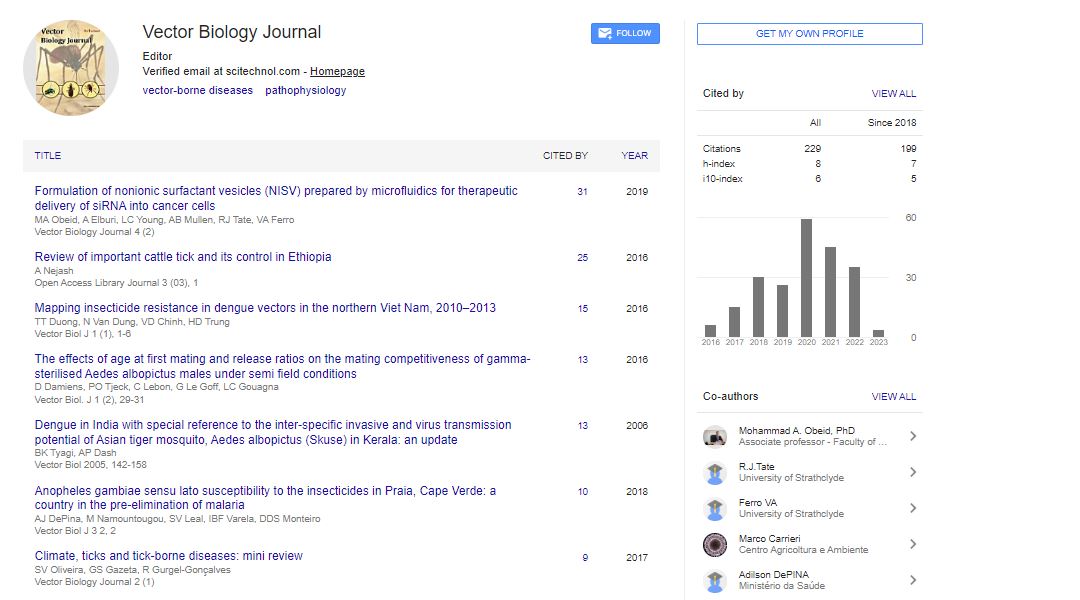Commentary, Vector Biol Vol: 8 Issue: 2
An Overview on Parasite Host Response: Its Interactions and Adaptations
Hadfield Smit*
1Department of Environmental Sciences and Management, North-West University, Potchefstroom, South Africa
*Corresponding Author: Hadfield Smit,
Department of Environmental Sciences
and Management, North-West University, Potchefstroom, South Africa
E-mail: smithad_field@edu.za
Received date: 30 May, 2023, Manuscript No. VBJ-23-107304;
Editor assigned date: 02 June, 2023, PreQC No. VBJ-23-107304 (PQ);
Reviewed date: 16 June, 2023, QC No. VBJ-23-107304;
Revised date: 23 June, 2023, Manuscript No. VBJ-23-107304 (R);
Published date: 30 June, 2023, DOI: 10.4172/2473-4810.1000265
Citation: Smit H (2023) An Overview on Parasite Host Response: Its Interactions and Adaptations. Vector Biol 8:2.
Description
Parasitism is a remarkable phenomenon found across various organisms in the natural world. Parasites rely on a host organism to full fill their essential needs for survival, reproduction, and development. In this context, the term "parasite host" refers to the organism that harbors and supports the life cycle of a parasite. The relationship between a parasite and its host is often complex, involving a range of adaptations and interactions that shape their coexistence.
Types of parasite hosts
A parasite host can be defined as an organism that provides the necessary environment, resources, and protection for the survival and reproduction of a parasite. Parasite hosts can be categorized into two primary types: definitive hosts and intermediate hosts.
Definitive hosts: Definitive hosts harbor the adult or sexually mature stages of a parasite. These hosts are essential for the completion of the parasite's life cycle. Examples include humans acting as definitive hosts for the malaria parasite (Plasmodium falciparum) or dogs acting as definitive hosts for the tapeworm (Echinococcus granulosus). Definitive hosts often exhibit specific adaptations that enable them to accommodate and disperse the parasite's reproductive stages.
Intermediate hosts: Intermediate hosts, on the other hand, harbor the larval or asexual stages of a parasite. They are crucial in facilitating the development and transmission of the parasite to its definitive host. Examples of intermediate hosts are snails acting as intermediate hosts for the liver fluke (Fasciola hepatica) or mosquitoes acting as intermediate hosts for the filarial worm (Wuchereria bancrofti). Intermediate hosts are often manipulated by parasites to enhance their transmission to the definitive host, sometimes causing physiological changes or behavioral alterations.
Interactions and adaptations
The relationship between a parasite and its host is a dynamic interplay driven by coevolutionary processes. Parasites have evolved various strategies to exploit their hosts, while hosts have developed mechanisms to defend themselves against parasitic infections. Here are some notable interactions and adaptations observed in parasite hosts:
Immunological interactions: Host immune responses play a vital role in combating parasite infections. Parasites have evolved mechanisms to evade or suppress host immune defenses. For instance, malaria parasites (Plasmodium spp.) can modify the surface proteins of infected red blood cells, evading detection by the host's immune system. Similarly, helminths produce immunomodulatory molecules that dampen the host immune response, allowing their survival.
Behavioral modifications: Parasites often manipulate the behavior of their hosts to enhance their transmission. This phenomenon is known as host manipulation. For example, the hairworm parasite (Spinochordodes tellinii) infects grasshoppers and alters their behavior, compelling them to jump into water, where the parasite can complete its life cycle. Such behavioral modifications increase the likelihood of the parasite reaching its next host.
Coevolutionary arms race: Parasites and hosts engage in an evolutionary arms race, where each tries to outwit the other. Hosts develop defense mechanisms, such as immune responses or physical barriers, to prevent parasite infections. In response, parasites evolve adaptations to overcome these defenses. This ongoing battle of adaptations drives the evolution of both parasites and their hosts.
Parasite hosts represent a diverse array of organisms that participate in complex interactions with their parasitic counterparts. Their adaptations, interactions, and ecological implications highlight the intricate nature of parasite-host relationships. Studying parasite hosts not only deepens our understanding of the natural world but also holds significant implications for public health, conservation, and ecosystem management.
 Spanish
Spanish  Chinese
Chinese  Russian
Russian  German
German  French
French  Japanese
Japanese  Portuguese
Portuguese  Hindi
Hindi 